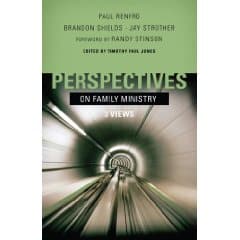This post is a review and summary of Perspectives on Family Ministry: Three Views. Ed. by Timothy Paul Jones. Nashville: Broadman and Holman Academic, October 2009. 213 pp.
Introduction
 Dr. Timothy Paul Jones, the editor of this book, served for fourteen years in vocational ministry. He is now an Assistant Professor of Leadership and Church Ministry at The Southern Baptist Theological Seminary in Louisville, Kentucky. His passion is to see the church come alongside families and teach them how to fulfill the commandment given in Deut. 6:7, “You shall teach them (God’s words) diligently to your children.”
Dr. Timothy Paul Jones, the editor of this book, served for fourteen years in vocational ministry. He is now an Assistant Professor of Leadership and Church Ministry at The Southern Baptist Theological Seminary in Louisville, Kentucky. His passion is to see the church come alongside families and teach them how to fulfill the commandment given in Deut. 6:7, “You shall teach them (God’s words) diligently to your children.”
He recognizes that there is a movement within evangelical churches to better minister to families. He has aided our understanding of this movement through the contributions of three pastors serving “in the trenches.” The format of the book was argument for, two responses against, and a final response in favor for each of the three models.
Paul Renfro, pastor of discipleship at Grace Family Baptist Church in Spring, Texas, writes concerning the Family-Integrated Model. Brandon Shields, minister to high school students at Highview Baptist Church in Kentucky and Indiana writes of their use of the Family-Based Model. Finally, Jay Strother, minister to emerging generations at Brentwood Baptist Church in Nashville, Tennessee, writes in favor of Family Equipping Ministry.
Family-Integrated Church, Paul Renfro
The family-integrated model jettisons all age-graded ministries. Those who adhere to this model view each family unit (single or married, with or without children) as one “block” that comprises the local church. That is, they view the church as a family of families. They view the church’s purpose as equipping the parents, primarily the fathers, to evangelize and disciple their children.
Some difficulties to this model include that a “family of families” cannot define the church which is defined as the “body of Christ” in Ephesians 4. There seems to be an inability to reach public school families as well as the non-traditional families that are prevalent today. Finally, there is still the challenge of equipping the children to engage the culture with their faith.
Family-Based, Brandon Shields
The are two values that are foundational to this philosophy, Brandon is careful to use this term over and above “model,” are flexibility and balance. Flexibility is essential because every church is different and therefore every church must adapt to their culture. Balance is also necessary because not every family in the local church is a “traditional” family. There are many challenges with blended families, single families, and other situations that must be handled with care when discipling the family. They do not see a need to radically reorganize and restructure the present ministry model. The key concept is the philosophical shift wherein the activities and programs are used to draw the families closer together.
Some problems with this particular model include the appearance that there is a greater concern for being culturally relevant rather than biblical. Some believe this model does not go far enough in addressing the disconnect between the church and the home. It is still too programmatic and does not really offer clear training to the parents to disciple their children.
Family-Equipping, Jay Strother
Pastor Jay explains in a diagram that the family-equipping model of ministry has a three-pronged approach. First, there are the catalysts. These are the parents who are primarily responsible to disciple their children and then the small group leaders in the church who lead Bible studies that reinforce the spiritual truths taught at home. Second, the content of what is being taught is intentional so that as the child grows, he meets certain “milestones” in his spiritual training at the church. Finally, the context of the model is found in worshipping Christ through small-group discipleship and serving in the church and community for the sake of the gospel.
Objections to the model include the parents simply do not have the time to disciple their children which then begs the question of how to confront parents who are not discipling their children. Also, the reasons offered for leaving other models were simply not convincing enough and therefore does not warrant a wholesale change of mindset. Finally, the question of strategy is too limited in scope and need not be the cause for the adoption of this ministry model.
Conclusion
This volume offers much to think about in the way of how the church should minister to the family. All three models are rooted in Scripture and all three models are driven by a love for the church and the family. Each pastor is passionate about seeing our world impacted by the church with more efficiency and more zeal. More importantly, each pastor writes and ministers with an urgency to change the landscape of the home through their respective views of family ministry.
The formatting of this book—with the point, counterpoint, and response method—offers the reader a balanced perspective. This book will be a great tool for church leaders who want to better address the family unit in their ministry. I highly recommend this book. Many Evangelical churches are shifting paradigms; this book will help you make sense of these new approaches.
Special thanks to Terry Delaney who contributed this guest post. To read more of Terry’s book reviews visit Going To Seminary or Diary of a Seminary Student.
